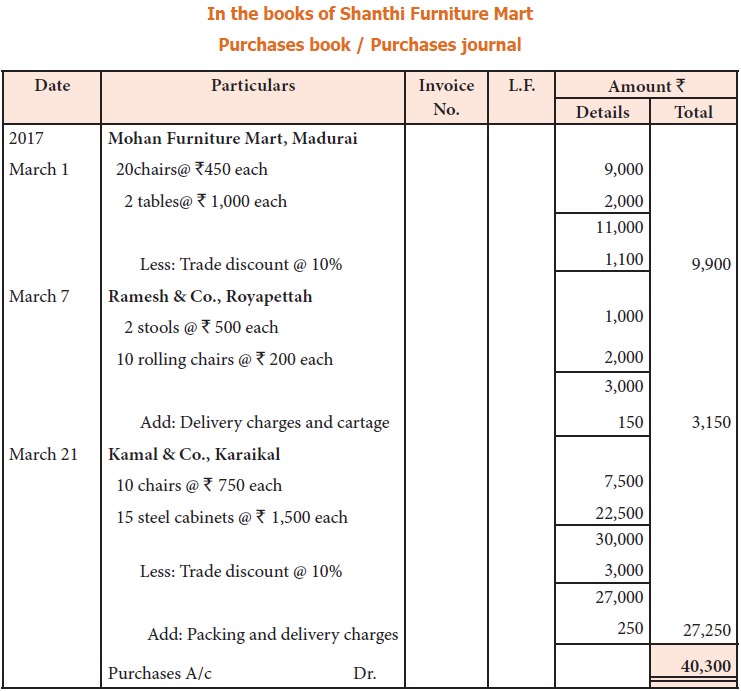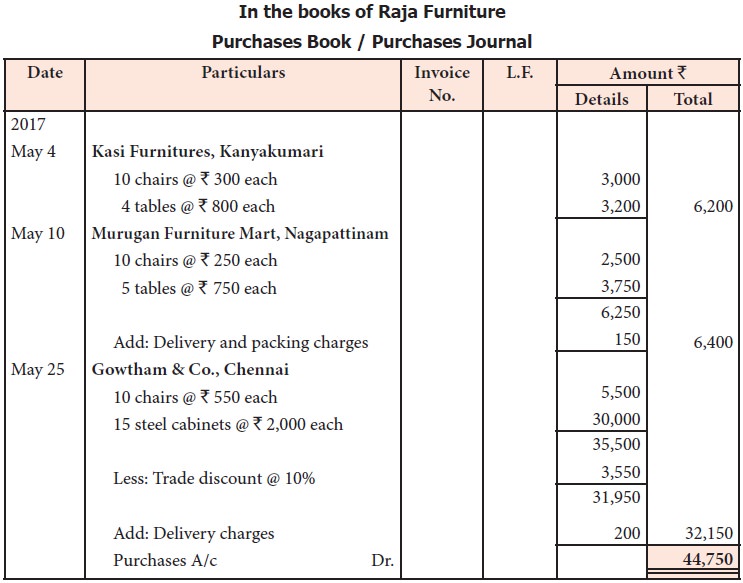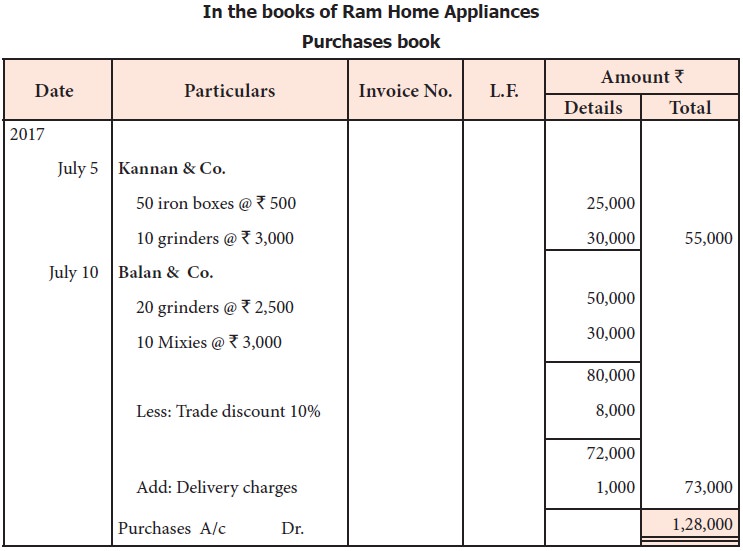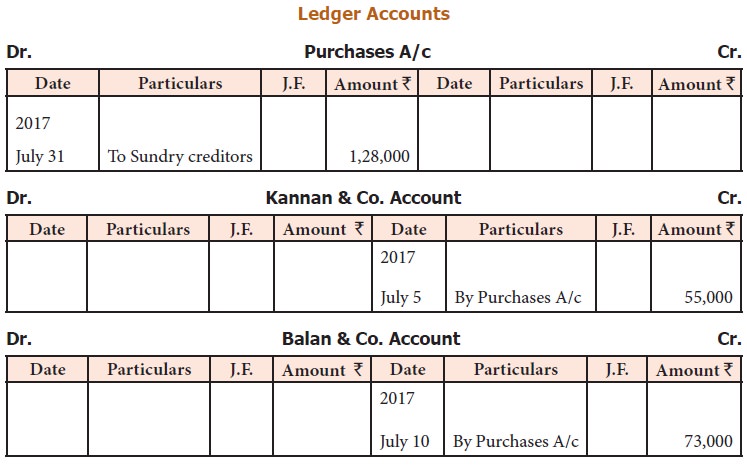Accountancy - Purchases book | 11th Accountancy : Chapter 6 : Subsidiary Books - I
Chapter: 11th Accountancy : Chapter 6 : Subsidiary Books - I
Purchases book
Purchases book
Purchases
book is a subsidiary book in which only credit purchases of goods are recorded.
When business wants to know the information about the credit purchases of goods
at a glance, the information can be made available if purchases of goods on
credit are separately recorded.
Goods here mean the items in which the business
entity is dealing. In other words, it is the item which is purchased for
regular sales. For example, furniture will be treated as goods in the case of
the firm dealing in furniture. For other firms, which are not dealing in
furniture it will be an asset. Hence, while recording transactions in the
purchases book, it must be ascertained whether the credit purchase is related
to the item in which the firm is dealing. Purchases of assets and purchase of
goods for cash are not entered in purchases book.

i. Date
In the date
column, the date of purchases of goods on credit is recorded.
ii. Particulars
In this
column the name of the supplier from whom goods have been purchased and details
of goods purchased are given. It contains the name, quantity, quality and rate
of goods purchased, trade discount and any other specification and specialties
of the goods are recorded in this column.
iii. Invoice number
Invoice is
the statement prepared by the seller of goods. It contains details about the
goods, its price and other expenses incurred. The invoice number is entered in
this column.
iv. Ledger Folio (L.F.)
The page
number of the ledger in which the supplier’s account appears is recorded in
this column. Purchases of goods must be posted to the personal accounts of
suppliers. Purchases book contains the page number of supplier’s account in the
ledger. It helps in posting and also in checking the records.
v. Amount column (Details)
Amount column
is divided into two parts, i.e., details and total. The details column is used
to record the amount of various individual items purchased from a particular
supplier. The amount of trade discount allowed is deducted. This column is used
for adjustment of additions and subtractions.
vi. Total amount column (Total)
The net
amount payable to the supplier of goods is recorded in the total amount column.![]()
1. Invoice
Entries in
the purchases day book are made from invoices which are popularly known as
bills. Invoice is a business document or bill or statement, prepared and sent
by the seller to the buyer giving the details of goods sold, such as quantity,
quality, price, total value, etc. Thus, the invoice is a source document of
prime entry both for the buyer and the seller.
2. Trade discount
Trade discount is a deduction given by the supplier
to the buyer on the list price or catalogue price of the goods. It is given as
a trade practice or when goods are purchased in large quantities. It is shown
as a deduction in the invoice. Trade discount is not recorded in the books of
accounts. Only the net amount is recorded. Example: Suppose the sale of goods
for Rs.10,000 was made and 10% was allowed as trade
discount, the entry regarding sales will be made for Rs. 9,000 (10,000 – 10 per cent of 10,000). In the same way, purchaser of
goods will also record purchases as Rs. 9,000).
Illustration 1
Record the following transactions in the purchases
book of Shanthi Furniture Mart:
2017
March 1
Purchased from Mohan Furniture Mart, Madurai 20 chairs @ Rs. 450 each
2 tables @ Rs. 1,000 each
Less:
Trade discount @ 10%
March 7
Bought
from Ramesh & Co., Royapettah
2 stools
@ Rs. 500 each
10
rolling chairs @ Rs. 200 each
Delivery
charges and cartage Rs. 150
March 21
Purchased
from Kamal & Co., Karaikkal
10 chairs
@ Rs. 750 each
15 steel
cabinets @ Rs. 1,500
each
Packing
and delivery charges Rs. 250
Less:
Trade discount @ 10%
March 25
Purchased
from Jemini & Sons, Chennai
2
typewriters @ Rs. 7,750
for office use
Solution


Tutorial note
·
Trade discount is allowed on the purchase price of
goods excluding delivery charges and cartage.
·
Delivery
charges and cartage are direct expenses, chargeable from purchaser, so they are
added to the amount payable.
Illustration 2
Record the
following transactions in the purchases book of Raja Furniture:
2017
May 4
Purchased from Kasi Furnitures,Kanyakumari 10
chairs @ Rs. 300 each 4 tables @ Rs. 800 each
May 6
Purchased for cash from Welcome Furniture, Vellore
2 almirahs @ Rs. 2,000 each
4 chairs @ Rs. 200 each
Less: Trade discount 5%
May 10
Bought furniture from Murugan Furniture Mart,
Nagapattinam 10 chairs @ Rs. 250 each
5 tables @ Rs. 750 each
Delivery and packing charges Rs. 150
May 20
Purchased 2 computers for office use from Anandan
& Co., Adyar on credit for Rs.15,550
each
May 25
Purchased from Gowtham & Co., Chennai
10 chairs @ Rs. 550 each
15 steel cabinets @ Rs. 2,000
each
Delivery charges Rs. 200
Less: Trade discount 10%
Solution

Note:
·
Purchases on 6th May, 2017 will not be recorded in
the purchases book, because it is cash purchases.
·
Purchases of computers on 20th May, 2017 will not
be recorded in the purchases book, because computer is an asset for the firm
dealing in furniture and it is for office use.
3. Posting from purchases book
After the
transactions are recorded in the purchases book, posting them to ledger
involves two steps:
Step 1: Posting to personal accounts of creditors: Every day, each entry is
posted to the credit side of the respective personal account of the creditor
by entering the words ‘By Purchases account’.
Step 2: Posting to purchases account: Generally, at the end of the month, the purchases book is
totalled. The monthly total of purchases is posted to the debit side of
purchases account by writing the words ‘To Sundry creditors A/c’.
Illustration 3
From the following transactions of Ram Home
Appliances for July, 2017 prepare purchases book and ledger accounts connected
with this book:
2017
July 5 Purchased on credit from Kannan &
Co.
50 iron boxes @ Rs. 500 each
10 grinders @ Rs. 3,000 each
July 6 Purchased for cash from Siva &
Bros.
25 fans @ Rs. 1,250 each
July 10 Purchased from Balan & Co. on credit
20 grinders @ Rs. 2,500 each
10 mixies @ Rs. 3,000 each
Trade discount 10%
Delivery charges Rs. 1,000
July 20 Purchased on credit, one copier machine
from Kumar for Rs. 35,000
Solution

Ledger Accounts

Note: 6th July, transaction is a cash transaction and 20th July, transaction is purchase of an asset. Hence, both will not be recorded in the purchases book.
Related Topics